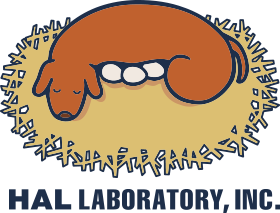HAL Laboratory
| HAL Laboratory, Inc. | |||
|---|---|---|---|

| |||
| Type | Private | ||
| Founded | February 21, 1980[1] | ||
| Headquarters | |||
| Key people | Satoru Iwata (former president), Masahiro Sakurai (former employee) | ||
| Industry | Video game industry | ||
| Products | Video games | ||
| Employees | 110 | ||
| Website | http://www.hallab.co.jp/ | ||
HAL Laboratory, Inc. (株式会社ハル研究所, Kabushikigaisha Haru Kenkyūjo) is a Japanese video game company that was founded on February 21, 1980. The company is best known for creating the Kirby series and the Super Smash Bros. series, and is a second-party developer for Nintendo.
History
HAL Laboratory was originally a group of friends who shared a desire to create video games, and started off making games for the MSX system and the Commodore 64, until Nintendo released their NES in 1983.[2]
In many of its games during the early to mid-'90s, it used the name HALKEN (derived from their literal Japanese name "HAL KENkyūjo"), as well as HAL Laboratory. Some of its early titles were also released as HAL America, a North American subsidiary of the company.
Iwata was president of HAL Laboratory before he become president of Nintendo. Masahiro Sakurai, who created the character Kirby and the Super Smash Bros. series, also worked at HAL, and now leads his own company, Sora Ltd.
HAL Laboratory-developed properties represented in Smash include the Kirby and EarthBound series, as well as the Nintendo-console SimCity games. HAL also developed several Pokémon spinoffs, such as the Pokémon Stadium games, which are referenced in Smash.
Development History
1999
- Super Smash Bros.
- Developer
2001
- Super Smash Bros. Melee
- Developer
Trivia
- Often believed to be derived from the HAL 9000 computer in the novel and film 2001: A Space Odyssey, an interview with Iwata reveals that its name is a pun of the IBM company: each letter puts them a step ahead of IBM (the letters H, A and L come before the letters I, B and M, respectively)[3].
External links
- HAL Laboratory, Inc (Japanese)
- Iwata interview
- N-Sider page (HAL Laboratory company profile)
References
- ^ HAL Laboratory, Inc. Company. Retrieved on 2007-09-17.
- ^ http://www.commodore.ca/history/people/michael_tomczyk.htm
- ^ http://www.nintendolife.com/news/2012/11/iwata_explains_where_the_name_hal_laboratory_came_from
| Companies involved in the Super Smash Bros. series | |
|---|---|
| First- and second-party | Nintendo (Monolith Soft · Retro Studios) · HAL Laboratory · Game Freak · Creatures · Intelligent Systems · Rare Ltd. · Sora Ltd. |
| Third-party | Konami · Sega (Atlus) · PlatinumGames · Capcom · Bandai Namco · Square Enix · Microsoft (Rare Ltd. · Mojang Studios) · SNK · Disney |
| Other related | Game Arts · Hatena · Havok · Paon DP · Tri-Crescendo · List of companies with minor representation |
